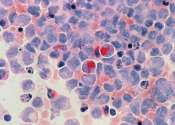Grape seed extract kills head and neck cancer cells, leaves healthy cells unharmed
Nearly 12,000 people will die of head and neck cancer in the United States this year and worldwide cases will exceed half a million.
Jan 27, 2012
18
4
Nearly 12,000 people will die of head and neck cancer in the United States this year and worldwide cases will exceed half a million.
Jan 27, 2012
18
4
Recently published research from The University of Southern Denmark and the Danish Cancer Society shows a connection between one of the most common medications for hypertension and skin cancer. Danish researchers set their ...
Dec 5, 2017
0
550
Adults aged 45 to 64 experienced a nearly doubled rate of esophageal cancer and a 50 percent increase in the precancerous condition Barrett's esophagus between 2012 and 2019, according to a database analysis of roughly five ...
May 13, 2022
0
100

It's well known that keeping blood glucose levels in check can help individuals avoid or manage diabetes, but new research led by biologists at The University of Texas at Dallas suggests that restricting blood glucose levels ...
Aug 13, 2019
0
1052

A customized patch treatment for basal cell carcinoma completely destroys facial tumors without surgery or major radiation therapy in 80 percent of patients studied, say researchers at the Society of Nuclear Medicine's 2012 ...
Jun 11, 2012
0
0
More than a dozen bacterial species among the hundreds that live in people's mouths have been linked to a collective 50% increased chance of developing head and neck squamous cell carcinoma (HNSCC), a new study shows. Some ...
Sep 26, 2024
0
142

In a new study, scientists at The University of Texas at Dallas have found that some types of cancers have more of a sweet tooth than others.
May 26, 2017
1
433

What drives tumor growth? Is it a few rogue cells imposing their will upon healthy tissue, or diseased tissue bringing out the worst in otherwise peaceable cells? Or is it a back-and-forth, a dialogue between the two? According ...
Nov 30, 2022
0
648

A new paper in Nature Communications reveals new insights into adaptations made by cancer cells to rewire their metabolism to achieve growth and survive. Among the discoveries include a challenge to a well-known feature in ...
Mar 23, 2022
0
8

A team of researchers affiliated with a large number of institutions in Germany has tested several machine-learning algorithms to see how well they can identify the differences between lung tumors associated with head and ...

Squamous cell carcinoma (SCC or SqCC) is a form of skin cancer. Skin cancers fall into two groups, melanoma and non-melanoma; squamous cell carcinoma is a non-melanoma cancer. It is one of the most common cancers in humans and other animals.
Squamous cells are a type of epithelium cell forming the outermost layers of the skin and some organs in the body. Squamous cell carcinoma usually occurs on the skin, especially portions commonly exposed to the Sun, the face, ears, neck, hands, or arm. The main symptom is a growing bump that may have a rough, scaly surface and flat reddish patches. It may also occur inside the body wherever squamous cells are found, including the esophagus, urinary bladder, prostate, lung, vagina, and cervix, among others.
Despite the common name, squamous cell carcinomas arising in different body sites can show tremendous differences in their presenting signs and symptoms, natural history, prognosis, and response to treatment.
Though the use of these terms has been decreasing in the literature, SqCC is still sometimes referred to as "epidermoid carcinoma" and "squamous cell epithelium". During its earliest stages, it is sometimes known as "Bowen's disease".
This text uses material from Wikipedia licensed under CC BY-SA